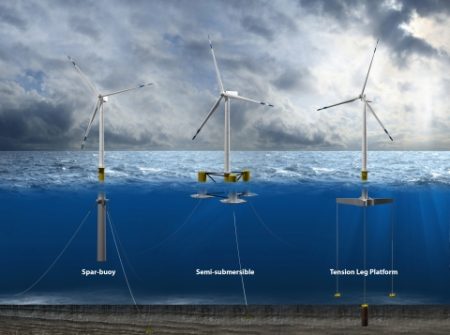July 6, 2017 – If you are in the energy business then you might call this the year of floating offshore wind farms. Whether off Scotland, Japan, France, Portugal, Spain, Califonia, or Hawaii, the move to non-fixed sites is growing.
Offshore wind turbines are a business less than three decades old. The first site was built off the Danish coast in 1992. Today several thousand offshore wind turbines are installed around the world. In 2014 these sites had a generating capacity of just under 9,000 Megawatts. All were built close to shore because it was easier to erect them above a shallow seabed.
Why floating over fixed?
Fixed offshore wind turbines are a shallow water phenomenon. That means they are close to shore which some consider an eyesore, especially those who have purchased expensive homes for the sea view. NIMBYism makes further fixed offshore installations problematic. And fixed means less flexibility, that is, once built you can’t move the installation. If your wind yields don’t match the science and data you collected prior to the build, you are out of luck?
Floating turbines provide a flexible option. They can be out of sight of those expensive homes that purchased sea views. They can be placed where the depth of water makes it a fixed installation improbable to impossible.
Floating turbines have the ability to operate on the ocean or on lakes where studies show a much greater continuous wind data. And floating wind turbines can be much bigger than their land-based cousins. With bigger turbine blades it means greater energy production per installed turbine and, therefore, fewer unit installations to achieve significant power generation. States Johan Slatte of DNV GL, “this is….technology that has the potential to enable us to reach the high-energy yield sites without being limited by water depth.”
How do floating wind turbines remain stable?
The turbines are anchored to the sea floor and held in place by multiple cables. The cables serve two purposes. They keep the turbine stationary in high seas and also serve as transmission lines linked to seafloor cables connected to the onshore. The turbines must remain vertically stable regardless of wave, wind, and current. That has led to almost 30 different designs. Many use undersea floats with ballast tanks that can be filled partially with seawater. The one seen on the left in the image below, called spar buoy, uses an adjustable ballast. The variable counterweight created by the ballast helps the turbine maintain continuous vertical stability. Two other more popular configurations appear to the right in the picture.
When was the first floating wind turbine built?
The first operational floating commercial wind turbine was deployed in 2009 off the coast of Norway. Built by Siemens, the structure was installed 10 kilometers (approximately 6 miles off shore) with the seabed 220-meters (720 feet) below. The structure included a counterbalance float 100 meters (330 feet) in depth below the sea surface. By 2010 the site was generating 7.3 Gigawatt hours of electricity and had survived 11-meter (36-foot) swells with no damage.
What’s the future for floating wind turbines?
It’s looking pretty good. The National Renewable Energy Laboratory in the United States sees floating wind turbines as critical to Hawaii’s plans to be 100% renewable energy by 2045. A 50 floating wind turbine project application is in the submission stage. The installation would sit 24 kilometers (15 miles) off Oahu’s coast where the seafloor is 600 meters (almost 2,000 feet) below.
Off Europe’s coast sites where the seafloor is greater than 60 meters (200 feet) below have the potential to generate 4,000 Gigawatts of energy.
The United States has mapped out offshore sites capable of generating 2,450 Gigawatts.
Japan calculates 500 Gigawatts of offshore capacity.
Turbine blades measuring 80 meters (over 260 feet) will create as much as 20 Megawatts output from a single wind turbine unit. That’s more than 4 times the amount of energy generated by the average land-based or fixed system.
Other advantages: if the turbines need maintenance they can be brought to land and repaired, and if wind conditions are better elsewhere the turbines can be towed to a new location.
New capacity coming online includes three projects off Scotland with a capacity of 90 Megawatts, two off the French and United Kingdom coasts, each generating 100 Megawatts, and two 30 Megawatt projects, one off Eire and the other Portugal. All will be operational from this year to 2021.
Remaining challenges include dealing with the ocean’s impact on materials from the foundation anchors and ballasts, to the mooring lines, to the power cables and connectors running along the seafloor at variable depths. Designs for floating and submerged substations are under consideration.








